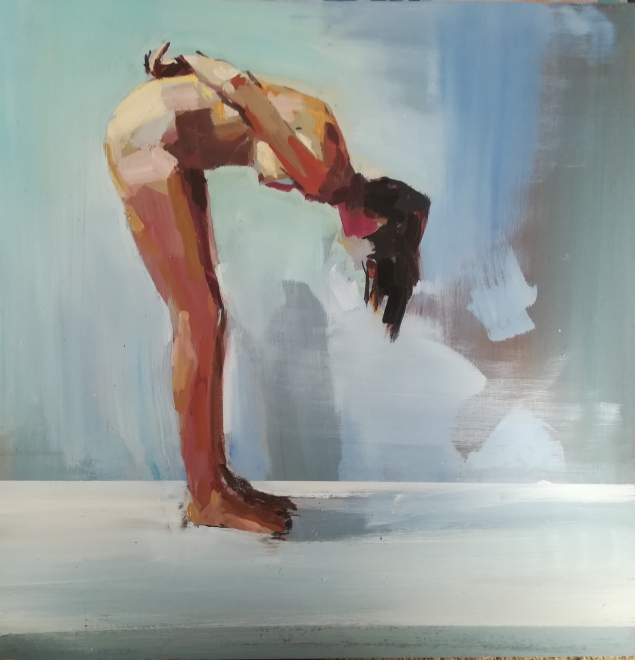“How do you paint the female nude without it being sexualised? And how do you paint the figure in a fresh and exciting way?” Sky Portrait Artist of the Year 2018 quarterfinalist Philip Tyler investigates these questions in his current body of work.
Triangles by Philip Tyler
The British artist has explored the nude for the last 20 years. His first nudes explored grief and loss, prompted by the loss of his mother. Later, Philip became interested in the sculptural presence of the figure in space. We ask Philip about his life as an artist and his interpretation of the classic nude.
100 Days by Philip Tyler
What about life drawing appeals to you and how have you reinterpreted this classic style?
Life drawing is an endlessly fascinating subject. The figure is complex, it moves, it breathes, whether nude or clothed it is never the same and it always provides a new challenge. How I look at the figure and respond to what I see is central to my artistic approach. The history of life drawing is a rich resource and inspires me to push myself and never be content.
Off Centre by Philip Tyler
You explore many themes in your work, including grief and loss. What do you explore in your life drawing specifically?
Death has featured heavily in my work, as I have lost both my brother and my father in the last six years. I am near the age that my brother died and I am conscious of my own mortality. I carry an emotional weight that impacts my work.
Forest by Philip Tyler
Since the mid 90’s I have explored the nude, and in its first incarnation, my male nudes explored ideas of grief and loss through gesture, lighting, colour and atmosphere. These were all naked self-portraits full of despair after my mum had suddenly died from a heart attack.
Covering Up by Philip Tyler
My female nudes came much later as I was interested in looking at a different physicality other than my own. I wanted to think about the sculptural presence of the figure in a particular space. Colour became something much more sensuous, more about beauty.
Lyndsey Lying Down by Philip tyler
I took some time away from painting the nude but returned to the subject seven years ago. I did a lot of experimentation with oil paint as I never felt that I had fully got to grips with it and considered questions such as how do you paint the female nude without it being sexualized? And how do you paint the figure in a fresh and exciting way? This informed the writing of my first book “Drawing and painting the nude”.
Johanna at Jakes by Philip tyler
Can you tell us about your process?
I take thousands of photographs on my phone. I store my photographs and they often sit for years as embryonic ideas waiting to hatch. Some might never manifest into work whilst other images might be returned to again and again.
Looking In by Philip Tyler
What are the motivations behind the titles of your nudes?
Titles are funny things. I have been a massive fan of Richard Diebenkorn since the mid 80’s and always loved the fact that he would use the same title for a body of works. For a while, my works were called ‘Untitled’ but this made it difficult to catalogue. I then used generic themed titles such as ‘Orpheus’ or ‘Daedalus’. Recently I have been using song titles as well as specific titles which relate to my models.
Bend by Philip Tyler
My studio is quite small so I have to resort to working from photos. I am quite shy and it takes time to get to know a model well enough to ask them to be photographed. This is only something that can come from a position of trust, and the best photo sessions happen when my model comes to the session with ideas in response to my work.
Curve by Philip Tyler
The faces of your figures tend to be blurred. Is there any meaning underlying this?
I am interested in the whole body as a presence in space. These are not portraits and I have always loved how Sickert’s nudes communicate everything you need to know about that experience without resorting to painting intricate features. If I can find a shorthand to express the gesture eloquently I am happy.
Lyndsey's Coast 2 by Philip Tyler
What are your ambitions for 2019?
Last year I was a quarter finalist on the Sky Portrait Artist of the year, where I painted Michael Ball. After losing out to the eventual winner on my round I was inspired and painted or drew every sitter that appeared in S4 and S3. These paintings are made purely for my own pleasure. I have just entered the BP portrait award and I am sure that I will be entering the Ruth Borchard self portrait prize, The ING Discerning eye and any other competition that might strike my fancy.
BROWSE PHILIP'S WORK >>












